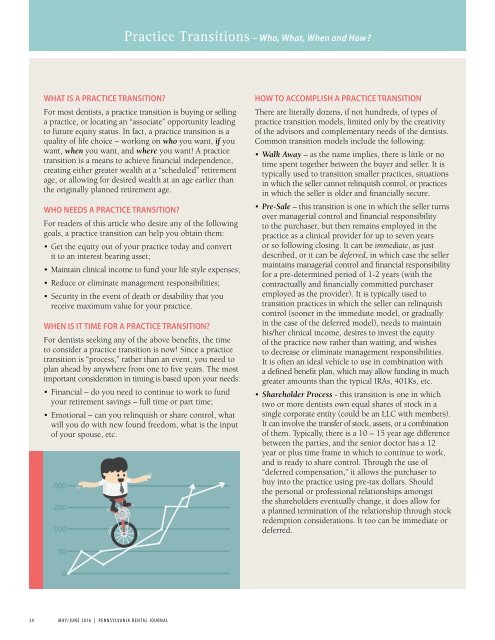MAY/JUNE
1TvnmH5
1TvnmH5
Create successful ePaper yourself
Turn your PDF publications into a flip-book with our unique Google optimized e-Paper software.
Practice Transitions – Who, What, When and How?<br />
WHAT IS A PRACTICE TRANSITION?<br />
For most dentists, a practice transition is buying or selling<br />
a practice, or locating an “associate” opportunity leading<br />
to future equity status. In fact, a practice transition is a<br />
quality of life choice – working on who you want, if you<br />
want, when you want, and where you want! A practice<br />
transition is a means to achieve financial independence,<br />
creating either greater wealth at a “scheduled” retirement<br />
age, or allowing for desired wealth at an age earlier than<br />
the originally planned retirement age.<br />
WHO NEEDS A PRACTICE TRANSITION?<br />
For readers of this article who desire any of the following<br />
goals, a practice transition can help you obtain them:<br />
• Get the equity out of your practice today and convert<br />
it to an interest bearing asset;<br />
• Maintain clinical income to fund your life style expenses;<br />
• Reduce or eliminate management responsibilities;<br />
• Security in the event of death or disability that you<br />
receive maximum value for your practice.<br />
WHEN IS IT TIME FOR A PRACTICE TRANSITION?<br />
For dentists seeking any of the above benefits, the time<br />
to consider a practice transition is now! Since a practice<br />
transition is “process,” rather than an event, you need to<br />
plan ahead by anywhere from one to five years. The most<br />
important consideration in timing is based upon your needs:<br />
• Financial – do you need to continue to work to fund<br />
your retirement savings – full time or part time;<br />
• Emotional – can you relinquish or share control, what<br />
will you do with new found freedom, what is the input<br />
of your spouse, etc.<br />
HOW TO ACCOMPLISH A PRACTICE TRANSITION<br />
There are literally dozens, if not hundreds, of types of<br />
practice transition models, limited only by the creativity<br />
of the advisors and complementary needs of the dentists.<br />
Common transition models include the following:<br />
• Walk Away – as the name implies, there is little or no<br />
time spent together between the buyer and seller. It is<br />
typically used to transition smaller practices, situations<br />
in which the seller cannot relinquish control, or practices<br />
in which the seller is older and financially secure.<br />
• Pre-Sale – this transition is one in which the seller turns<br />
over managerial control and financial responsibility<br />
to the purchaser, but then remains employed in the<br />
practice as a clinical provider for up to seven years<br />
or so following closing. It can be immediate, as just<br />
described, or it can be deferred, in which case the seller<br />
maintains managerial control and financial responsibility<br />
for a pre-determined period of 1-2 years (with the<br />
contractually and financially committed purchaser<br />
employed as the provider). It is typically used to<br />
transition practices in which the seller can relinquish<br />
control (sooner in the immediate model, or gradually<br />
in the case of the deferred model), needs to maintain<br />
his/her clinical income, desires to invest the equity<br />
of the practice now rather than waiting, and wishes<br />
to decrease or eliminate management responsibilities.<br />
It is often an ideal vehicle to use in combination with<br />
a defined benefit plan, which may allow funding in much<br />
greater amounts than the typical IRAs, 401Ks, etc.<br />
• Shareholder Process - this transition is one in which<br />
two or more dentists own equal shares of stock in a<br />
single corporate entity (could be an LLC with members).<br />
It can involve the transfer of stock, assets, or a combination<br />
of them. Typically, there is a 10 – 15 year age difference<br />
between the parties, and the senior doctor has a 12<br />
year or plus time frame in which to continue to work,<br />
and is ready to share control. Through the use of<br />
“deferred compensation,” it allows the purchaser to<br />
buy into the practice using pre-tax dollars. Should<br />
the personal or professional relationships amongst<br />
the shareholders eventually change, it does allow for<br />
a planned termination of the relationship through stock<br />
redemption considerations. It too can be immediate or<br />
deferred.<br />
34<br />
<strong>MAY</strong>/<strong>JUNE</strong> 2016 | PENNSYLVANIA DENTAL JOURNAL


